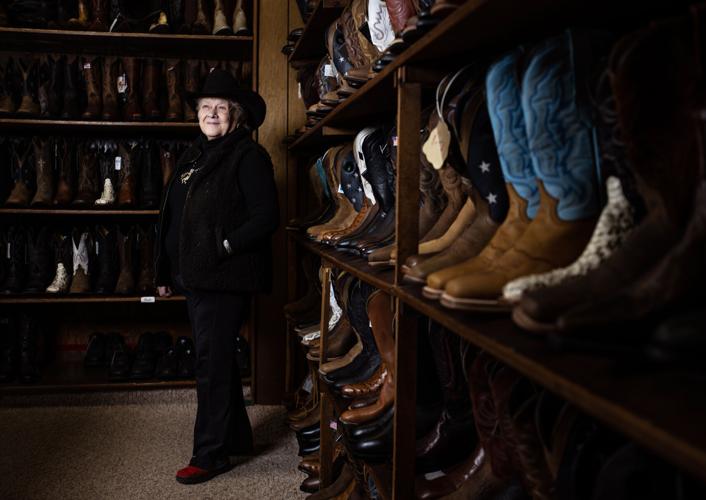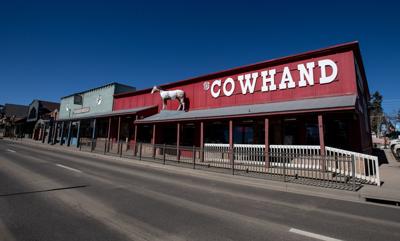WOODLAND PARK • On quiet days like these in her family’s nearly 60-year-old western store, it’s easy for Merry Jo Larsen to look out the window, to look just past the main street traffic, and reminisce.
She points across the street, to the vacant park in the middle of town. “See those patches of dirt there?” Larsen says. “Used to be a 60-by-80 clubhouse there.”

Ute Pass Historical Society maintains photos like these showing Woodland Park’s history of rodeos.
That was the old Saddle Club, marked by grandstands surrounding the old rodeo grounds. There was dancing, too. Across the road — today’s four-lane highway was dirt and two lanes back then, Larsen remembers — people would mosey over for any stitching-up they might’ve required for their pants, dresses, boots and cowboy hats. The Cowhand was always there.

Merry Jo Larsen, owner of The Cowhand, poses for a portrait in the boot room of the shop last month in Woodland Park. Her family has owned the western store for nearly 60 years.

Although The Cowhand still remains stocked with boots, hats, Wranglers and men’s and women’s clothes for working and dancing, the inventory has evolved over the decades to cater to tourists with T-shirts and souvenirs.
As it still is today, impossible to miss driving through Woodland Park. The building maintains the same barn-red paint Larsen knew as a teen back in the 1960s.
“That was my mother,” Larsen says. “‘I want barn red. I want people to see it.’”
Larsen wants people to see the Cowhand now. She wants people to see the western store as she sees it: “I think this store represents the area,” she says. “What it used to be.”
Woodland Park, she says, used to be a “straight-up cowboy town.”

From her seat behind the counter at The Cowhand, Merry Jo Larsen has watched the town of Woodland Park change. Visitors can often find her sitting on her stool reading a magazine or chatting with locals.
That’s why her parents started the Cowhand — to be a small shop for tack. “We couldn’t buy a pair of reins in this little town,” Larsen says.
They’d be available, along with saddles and more, at the dude ranch her parents oversaw up the road in Divide, on land now consumed by houses.
“As the word got out,” Larsen recalls, “people said, ‘You gonna carry boots? You gonna carry hats? You gonna carry clothes?’ It morphed into a family western store.”

Merry Jo Larsen poses for a portrait among The Cowhand’s large section of hats on Thursday, Feb. 29, in Woodland Park.
In 1967, the Cowhand moved into the building that was the town’s grocery well before the Walmart and big box stores. Here the Cowhand remains, stocked, as it’s always been, with boots and hats and Wranglers and men’s and women’s clothes for working and dancing.
You don’t see much tack anymore. You see more stuff for tourists: T-shirts and sweatshirts and souvenirs.
There are signs of the “urban cowboy” that Larsen laments. She saw the fashion trend give way to Chinese manufacturing that filled chain-store racks and squeezed out fellow mom and pops. Chains like Cavenders, “a nice store,” Larsen says, but “it’s all about bling. ... That’s not what ranch people were.”

This photo dated 1956 shows a parade down Woodland Park’s main street, as part of the town’s old rodeo, Ute Trail Stampede. The Cowhand store, now located in the food market, today represents the town’s cowboy heritage. Photo courtesy Ute Pass Historical Society
She has resisted those rhinestone-lined jeans that look to her to be mighty uncomfortable in the saddle. Still, she stocks plenty of trendy pieces that appeal to city people — the kind of people visiting and increasingly populating Woodland Park.
“But we try to stay with that old, solid look,” Larsen says. Between the stylish flannels and dresses are the leathers and furs and boots and hats her kind of people always knew.

ABOVE: An assortment of belt buckles sits on a table inside The Cowhand on Thursday, Feb. 29, in Woodland Park.
“I am not against progress,” Larsen says, “but you can’t just throw the old away.”
She essentially saw the Saddle Club thrown away. The venue swapped hands as it fell into disrepair ahead of its 2008 demolition. It was the end of an era for Larsen’s parents, whose connection went beyond their store across the street.
Howard and Joan Stull met at the Saddle Club. He was a cowboy from the plains, a rodeo bulldogger. She was of a ranching family with roots in the region.

Merry Jo Larsen poses for a portrait in the Cowhand on Thursday, Feb. 29, 2024, in Woodland Park, Colo. (Parker Seibold, The Gazette)
Larsen’s great-grandparents vacationed in Lake George around the turn of the 1900s. That was around the time of the region’s acclaimed history: Colorado’s last great gold rush had started in 1890 in Cripple Creek. The Midland Terminal Railroad had been built through Woodland Park and Divide to haul ore for processing down in Colorado Springs — down Ute Pass, the nomadic trail-turned-wagon road-turned-highway.
The ore hauls stopped in 1949, according to Ute Pass Historical Society. That was the year Larsen was born.
“I joined the historical society to start doing some oral history, because there’s fewer and fewer of us all the time,” she says. “There’s a lot of history on the gold rush days and the turn of the century, then it stops in the ’50s and ’60s and on. But boy, a lot of stuff was happening.”
Her family’s dude ranch at Paint Pony Resort was among several from the day that Ute Pass Historical Society has chronicled. There was also the Skelton Ranch, the Brockhurst Ranch, the Rosebud and Triple B.
The society reports more rodeos around town than just the Ute Trail Stampede, which in 1949 moved to the site that would be the Saddle Club. There was another rodeo at Paradise Ranch, on the eastern edge of Woodland Park. The historical society notes the ranch’s last remaining building, the main lodge, was razed in 2015.
The society also notes the Wild West aspects of the town — “a hot spot for gambling, dancing and illegal liquor.” Larsen’s dad, who took leadership positions at the Saddle Club over the years, knew some of the riffraff. He handled it, Larsen says.
“My dad was known to be a pretty good scrapper,” she says.
Howard Stull was known, of course, for the beloved Cowhand. As the ProRodeo Hall of Fame was coming together in Colorado Springs in the ’70s, he and Joan were asked to come down to roll out the gift store. The couple agreed to what would be a short stay ahead of Interstate 25 construction and surrounding development.
It was a kind of “turmoil,” Larsen says, that they could not escape back home. Woodland Park was changing, too.
Her parents were especially sad to see the Saddle Club go. They spent their later years in the Arizona countryside. “They said, ‘They ruined my little town,’” Larsen says.

Ute Pass Historical Society maintains photos like these showing Woodland Park’s history of rodeos.
Larsen stayed. She stayed right here at the Cowhand and watched the pavement and traffic pick up out her window.
No matter the changes, “it’s my town,” she says, “and I love this store.”
So there’s more touristy stuff than tack nowadays. “But I think we’re gonna start bringing more in,” Larsen says.
And one thing is for sure: the barn-red paint is staying.
















(0) comments
Welcome to the discussion.
Log In
Keep it Clean. Please avoid obscene, vulgar, lewd, racist or sexually-oriented language.
PLEASE TURN OFF YOUR CAPS LOCK.
Don't Threaten. Threats of harming another person will not be tolerated.
Be Truthful. Don't knowingly lie about anyone or anything.
Be Nice. No racism, sexism or any sort of -ism that is degrading to another person.
Be Proactive. Use the 'Report' link on each comment to let us know of abusive posts.
Share with Us. We'd love to hear eyewitness accounts, the history behind an article.